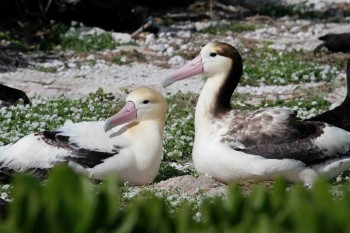The State of Hawaii’s Department of Land and Natural Resources, Division of Forestry and Wildlife is seeking a temporary-hire/volunteer Biological Technician for the summer 2014 field camp on Green Island, part of the Kure Atoll Wildlife Refuge.
Kure Atoll is a part of Papahānaumokuākea Marine National Monument (PMNM), the western-most atoll in the North-west Hawaiian Islands. Kure Atoll occupies a unique position referred to as the ‘Darwin Point’, which is the northern extent of coral reef development, and the atoll is estimated to be 29.8 million years old.
Kure is an important breeding site for a sizable and diverse population of wildlife, with several rare or endangered species. Eighteen species of seabirds nest on Kure Atoll, including ACAP-listed Black-footed or Kaʻupu Phoebastria nigripes and Laysan or Mōlī P. immutabilis Albatrosses. A female-female pair of Short-tailed Albatrosses P. albatrus have both laid on Kure eggs in recent years, but the eggs do nor hatch and are presumed infertile (click here).

Kure Atoll's female-female pair of Short-tailed Albatrosses
There are currently 15 native and 28 introduced plant species known. Native plants are an integral resource for seabird breeding habitat and dune stabilization. Invasive plants are a significant management concern because they displace native plant habitat and seabird nesting areas, entrap seabirds in dense vegetative mass and out-compete native plants.
Temporary-hire positions are for 20 weeks, the remainder of time will be voluntary (approximately 10 weeks). Deployment is to occur from March until September 2014. Personnel must be on Oahu and available to work at least one week prior to departure.
Applicants must be physically fit. “Must be in excellent health, able to walk 10 miles per day with a 40-lb pack, lift 50 lbs, work for long hours in hot/sunny, rainy/cold conditions and bend or stoop for long periods of time; must know how to swim; [have] knowledge of native Hawaiian species, excellent vision and plant identification skills.”
Click here for more information and how to submit an application.
For more information about Kure Atoll, visit the Kure Atoll Conservancy website and Facebook Page and the Papahānaumokuākea Marine National Monument website.
John Cooper, ACAP Information Officer, 12 December 2013

 English
English  Français
Français  Español
Español